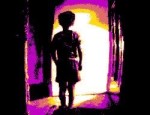Film Review
Passport to Pimlico is as much
a revealing piece of social commentary on Britain of the late 1940s as it is a
sublime, highly entertaining example of film comedy. At the time
the film was made, a few years after the end of the Second World War,
Britain's wartime austerity measures were still largely in force and
people were looking forward to less stringent times with considerable
anticipation. The film offered hope, but also a note of warning.
This is one of a series of highly regarded classic comedies made by
Ealing Studios in the late 1940s and early 1950s, films that combine
sophisticated farce with acerbic social satire (others include
The Lavender Hill Mob (1951)
and
The Man in the White Suit (1951)). It
is a film which both celebrates and mocks the attitudes of the British at the time. In
particular, it makes a great play of the British virtues that were so
widely demonstrated during WWII - solidarity in the face of a common
adversity, resilience to overwhelming hardship, and an indefatigable
spirit to see things through - the famous Blitz spirit.
Passport to Pimlico is pretty much a morality tale which shows what could happen
to Britain if the austerity measures were to disappear overnight.
Far from a Utopia, what we see is a rapid descent into anarchy, where
criminals profit the most and ordinary people end up missing the
earlier regime. The message is that a civilised society needs its
laws to maintain social cohesion, and that people don't realise how
important such laws are until they are suddenly taken away. If
that sounds like a piece of government propaganda, think again.
It is the government officials we see in the film who are subjected to
the most severe onslaughts of lampooning by screenwriter T.E.B. Clarke.
Most of the film was shot on an outdoor set built on a cleared bombsite
of Lambeth Road (a mile for Pimlico), which gives it a striking sense
of realism. It was the first (and best) of a handful of films
directed by Henry Cornelius, a refugee from Nazi Germany. The
cast includes such distinguished character actors as Stanley Holloway and
Margaret Rutherford, whose larger than life performances add greatly to
the film's enjoyment value. Future
Carry
On star Charles Hawtrey
puts in an appearance, alomg with some other familiar faces of the
period, Hermione Baddeley, Naunton Wayne and Basil Radford.
© James Travers 2008
The above content is owned by frenchfilms.org and must not be copied.
Film Synopsis
When an unexploded German bomb is detonated in an area of central
London, a lost vault of 15th Century treasure is revealed, along with a
royal charter which makes Miramont Place, Pimlico, the property of the
Duke of Burgundy. Since the charter has not been revoked, this
London street is technically an independent state belonging to
Burgundy. At first, the local residents rejoice at this news, as
it marks an end to rationing and drinking restrictions. But then
the downside becomes apparent. The area becomes awash with black
marketers and hoards of shoppers wanting to avoid paying purchase
tax. The Foreign Office reacts by imposing strict currency and
border controls...
© James Travers
The above content is owned by frenchfilms.org and must not be copied.



